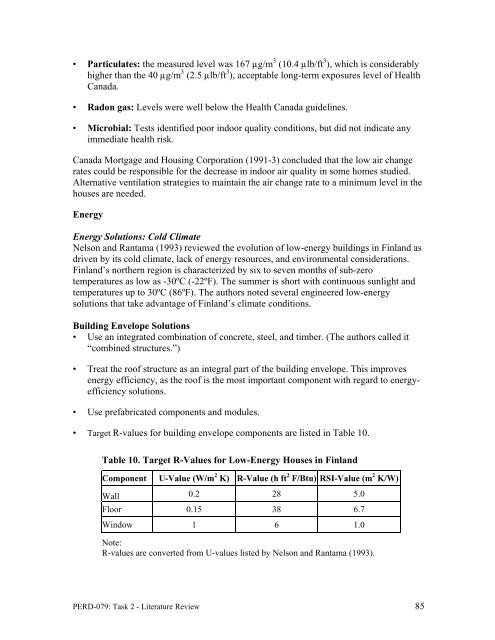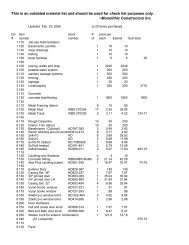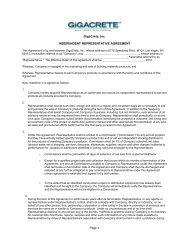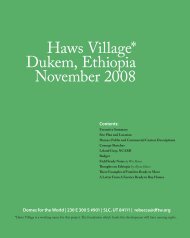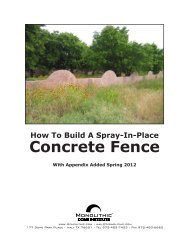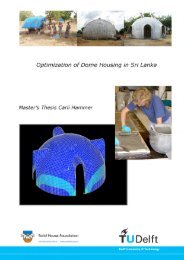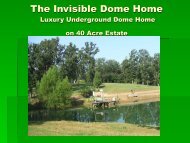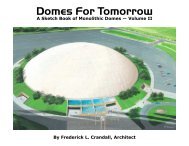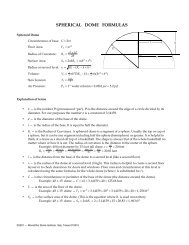Literature Review on Building Envelope, Heating and ... - Beeshive.org
Literature Review on Building Envelope, Heating and ... - Beeshive.org
Literature Review on Building Envelope, Heating and ... - Beeshive.org
Create successful ePaper yourself
Turn your PDF publications into a flip-book with our unique Google optimized e-Paper software.
• Particulates: the measured level was 167 µg/m 3 (10.4 µlb/ft 3 ), which is c<strong>on</strong>siderably<br />
higher than the 40 µg/m 3 (2.5 µlb/ft 3 ), acceptable l<strong>on</strong>g-term exposures level of Health<br />
Canada.<br />
• Rad<strong>on</strong> gas: Levels were well below the Health Canada guidelines.<br />
• Microbial: Tests identified poor indoor quality c<strong>on</strong>diti<strong>on</strong>s, but did not indicate any<br />
immediate health risk.<br />
Canada Mortgage <strong>and</strong> Housing Corporati<strong>on</strong> (1991-3) c<strong>on</strong>cluded that the low air change<br />
rates could be resp<strong>on</strong>sible for the decrease in indoor air quality in some homes studied.<br />
Alternative ventilati<strong>on</strong> strategies to maintain the air change rate to a minimum level in the<br />
houses are needed.<br />
Energy<br />
Energy Soluti<strong>on</strong>s: Cold Climate<br />
Nels<strong>on</strong> <strong>and</strong> Rantama (1993) reviewed the evoluti<strong>on</strong> of low-energy buildings in Finl<strong>and</strong> as<br />
driven by its cold climate, lack of energy resources, <strong>and</strong> envir<strong>on</strong>mental c<strong>on</strong>siderati<strong>on</strong>s.<br />
Finl<strong>and</strong>’s northern regi<strong>on</strong> is characterized by six to seven m<strong>on</strong>ths of sub-zero<br />
temperatures as low as -30ºC (-22ºF). The summer is short with c<strong>on</strong>tinuous sunlight <strong>and</strong><br />
temperatures up to 30ºC (86ºF). The authors noted several engineered low-energy<br />
soluti<strong>on</strong>s that take advantage of Finl<strong>and</strong>’s climate c<strong>on</strong>diti<strong>on</strong>s.<br />
<strong>Building</strong> <strong>Envelope</strong> Soluti<strong>on</strong>s<br />
• Use an integrated combinati<strong>on</strong> of c<strong>on</strong>crete, steel, <strong>and</strong> timber. (The authors called it<br />
“combined structures.”)<br />
• Treat the roof structure as an integral part of the building envelope. This improves<br />
energy efficiency, as the roof is the most important comp<strong>on</strong>ent with regard to energyefficiency<br />
soluti<strong>on</strong>s.<br />
• Use prefabricated comp<strong>on</strong>ents <strong>and</strong> modules.<br />
• Target R-values for building envelope comp<strong>on</strong>ents are listed in Table 10.<br />
Table 10. Target R-Values for Low-Energy Houses in Finl<strong>and</strong><br />
Comp<strong>on</strong>ent<br />
U-Value (W/m 2 K) R-Value (h ft 2 F/Btu) RSI-Value (m 2 K/W)<br />
Wall 0.2 28 5.0<br />
Floor 0.15 38 6.7<br />
Window 1 6 1.0<br />
Note:<br />
R-values are c<strong>on</strong>verted from U-values listed by Nels<strong>on</strong> <strong>and</strong> Rantama (1993).<br />
PERD-079: Task 2 - <str<strong>on</strong>g>Literature</str<strong>on</strong>g> <str<strong>on</strong>g>Review</str<strong>on</strong>g> 85


